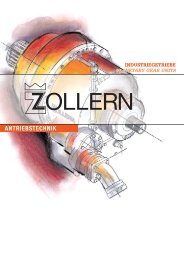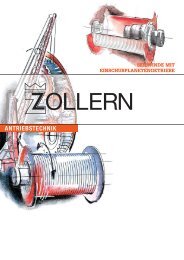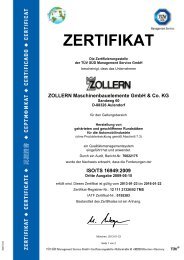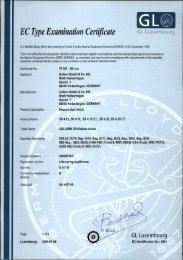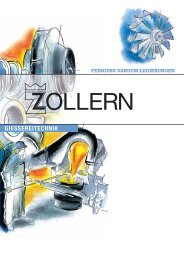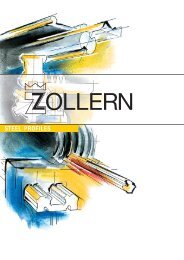FOUNDRY TECHNOLOGY - Zollern
FOUNDRY TECHNOLOGY - Zollern
FOUNDRY TECHNOLOGY - Zollern
You also want an ePaper? Increase the reach of your titles
YUMPU automatically turns print PDFs into web optimized ePapers that Google loves.
3. Dimensional accuracy<br />
3.1 Contraction and shrinkage<br />
During the solidification and cooling of cast metals, a contraction<br />
of the volume naturally occurs as a result of shrinkage.<br />
Other factors influencing the production of instrument<br />
castings can result from the shrinkage of the lost pattern and<br />
the expansion of moulds during heating. The sum of these<br />
influencing factors is taken into consideration in the shrinkage<br />
allowance during the manufacture of injection moulds.<br />
The shrinkage allowance is based on experience values,<br />
depending on the contour of the casting, the ceramic shell<br />
and the casting materials, as well as the casting techniques<br />
used in the individual foundries.<br />
Fig. 1<br />
The primary reference plane ‘A’ is fixed by three reference<br />
points A1, A2 and A3. These should represent the largest surface<br />
area of the casting. The secondary reference plane ‘B’ is<br />
fixed by two reference points B1 and B2, which should be<br />
arranged along the longitudinal axis. The tertiary reference<br />
plane ‘C’ has only a single reference point C!, which should<br />
lie at or near the centre of the casting.<br />
Fig. 2<br />
The reference planes are laid through the symmetrical axis<br />
of the casting.<br />
Reference plane locating points<br />
A1<br />
A3<br />
B2<br />
C1<br />
A2<br />
B1<br />
A plane<br />
B plane<br />
C plane<br />
Fig. 1 Fig. 2<br />
3.2 Reference planes and reference points<br />
Drawing used in the manufacture of casting must be gauged<br />
systematically using reference or locating points in order to<br />
ensure that dimensional checks and subsequent machining<br />
are in agreement. Reference points must be determined right<br />
from the early design stage and coordinated between the<br />
zero position of the reference planes is precisely defined by<br />
means of the reference point dimensions. All reference points<br />
must be arranged in such a way that they are not removed or<br />
altered during the subsequent machining process. Reference<br />
points should be positioned on the outside surfaces of the<br />
investment casting. They may take the form of raised or<br />
reference points are beneficial when dealing with castings<br />
with restricted shape and position tolerances. When determining<br />
the reference points, attention should be paid to<br />
ensuring that they do not fall in the area of a sprue. In case<br />
of complex shaping, it is possible in this way to position the<br />
casting precisely by (pre-) machining the locating points.<br />
3.3 Overdefinition<br />
According to DIN 406, overdefinition must be avoided.<br />
Wall thicknesses must always be specified.<br />
3.4 Mould and draught angles<br />
Mould and draught angles are not necessary as a general<br />
rule. Exceptions to this for reason of mouldmaking or casting<br />
necessity must be agreed between the investment casting<br />
supplier and the buyer.<br />
INVESTMENT CASTING



